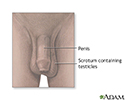Testicular self-exam
Screening - testicular cancer - self-exam; Testicular cancer - screening - self-exam
Testicular self-exam is an examination of the testicles that you do on yourself.
How the Test is Performed
The testicles (also called the testes) are the male reproductive organs that produce sperm and the hormone testosterone. They are located in the scrotum under the penis.
You can do this test during or after a shower. This way, the scrotal skin is warm and relaxed. It is best to do the test while standing.
- Gently feel your scrotal sac to locate a testicle.
- Use one hand to stabilize the testicle. Use your fingers and thumb of the other hand to firmly but gently feel the testicle. Feel the entire surface.
- Check the other testicle in the same way.
Why the Test is Performed
A testicular self-exam is done to check for testicular cancer .
Testicular cancer
Testicular cancer is cancer that starts in the testicles. The testicles are the male reproductive glands located in the scrotum.

Testicles have blood vessels and other structures that can make the exam confusing. If you notice any lumps or changes in a testicle, contact your health care provider right away.
Your provider may recommend that you do a testicular self-exam every month if you have any of the following risk factors:
- Family history of testicular cancer
- Past testicular tumor
-
Undescended testicle
Undescended testicle
Undescended testicle occurs when one or both testicles fail to move into the scrotum before birth.
 ImageRead Article Now Book Mark Article
ImageRead Article Now Book Mark Article
However, if a man has no risk factors or symptoms, experts do not know if doing testicular self-exam lowers the chance of dying from this cancer.
Normal Results
Each testicle should feel firm, but not rock hard. One testicle may be lower or slightly larger than the other.
Talk to your provider if you have questions.
What Abnormal Results Mean
If you find a small, hard lump (like a pea), have an enlarged testicle, or notice any other differences that do not seem normal, see your provider right away.
Call your provider if:
- You cannot find one or both testicles. The testicles may not have descended properly in the scrotum.
-
There is a soft collection of thin tubes above the testicle. This may be a collection of widened veins (
varicocele
).
Varicocele
A varicocele is the swelling of the veins inside the scrotum. These veins are found along the cord that holds up a man's testicles (spermatic cord)....
 ImageRead Article Now Book Mark Article
ImageRead Article Now Book Mark Article -
You have pain or swelling in the scrotum. This may be an infection or a fluid-filled sac (
hydrocele
) causing a blockage of blood flow to the area.
Hydrocele
A hydrocele is a fluid-filled sac in the scrotum.
 ImageRead Article Now Book Mark Article
ImageRead Article Now Book Mark Article
Sudden, severe (acute) pain in the scrotum or testicle that lasts for more than a few minutes is an emergency. If you have this type of pain, seek medical attention right away.
A lump in the testicle is often the first sign of testicular cancer. If you find a lump, see a provider right away. Most testicular cancers are very treatable. Keep in mind that some cases of testicular cancer do not show symptoms until they reach an advanced stage.
Risks
There are no risks with this self-exam.
References
American Cancer Society. Testicular self-exam. Last revised January 20, 2015. Available at: www.cancer.org/cancer/testicularcancer/moreinformation/doihavetesticularcancer/do-i-have-testicular-cancer-self-exam. Accessed October 2, 2015.
Friedlander TW, Ryan CJ, Small EJ, Torti F. Testicular cancer. In: Niederhuber JE, Armitage JO, Doroshow JH, Kastan MB, Tepper JE, eds. Abeloff's Clinical Oncology . 5th ed. Philadelphia, PA: Elsevier Churchill Livingstone; 2014:chap 86.
National Cancer Institute: Testicular Cancer Screening (PDQ). Bethesda, MD. Date last modified: July 19, 2012. Available at: www.cancer.gov/cancertopics/pdq/screening/testicular/Patient/page3. Accessed October 2, 2015.
U.S. Preventive Services Task Force. Screening for testicular cancer. U.S. Preventive Services Task Force reaffirmation recommendation statement. Ann Intern Med . 2011;154:483-6. PMID: 21464350 www.ncbi.nlm.nih.gov/pubmed/21464350 .
-
Male reproductive anatomy - illustration
The male reproductive structures include the penis, the scrotum, the seminal vesicles and the prostate.
Male reproductive anatomy
illustration
-
Testicular anatomy - illustration
The penis is the male organ of reproduction and also the organ of urinary excretion. The testes are a paired set of glands that produce sperm. The scrotum is the sac that houses the testes.
Testicular anatomy
illustration
-
Male reproductive anatomy - illustration
The male reproductive structures include the penis, the scrotum, the seminal vesicles and the prostate.
Male reproductive anatomy
illustration
-
Testicular anatomy - illustration
The penis is the male organ of reproduction and also the organ of urinary excretion. The testes are a paired set of glands that produce sperm. The scrotum is the sac that houses the testes.
Testicular anatomy
illustration
Review Date: 8/31/2015
Reviewed By: Jennifer Sobol, DO, Urologist with the Michigan Institute of Urology, West Bloomfield, MI. Review provided by VeriMed Healthcare Network. Also reviewed by David Zieve, MD, MHA, Isla Ogilvie, PhD, and the A.D.A.M. Editorial team.


